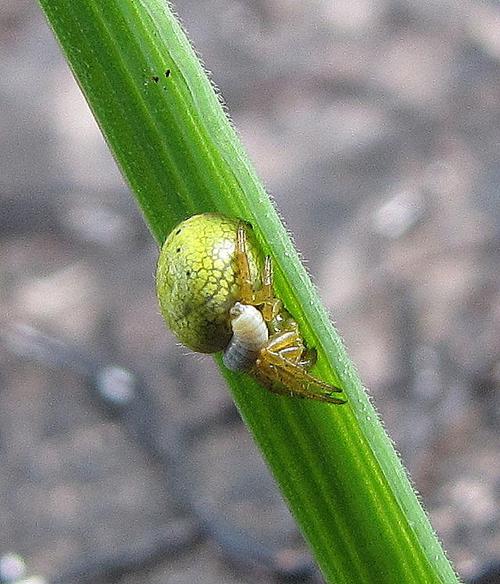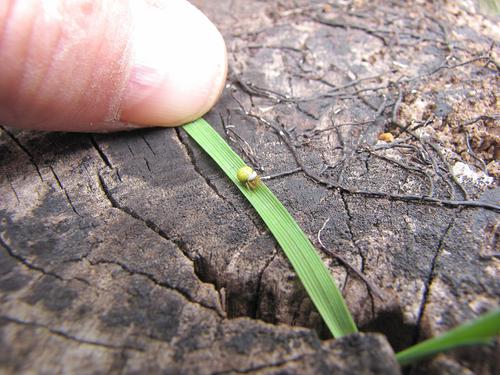
Paul Meers, Brett Westwood & Harry Green.
The three authors all played a part in the account set out below, with Harry Green writing the script. Those who know about spider ectoparasites may be mildly amused at our ignorance and sudden enthusiasm but as most readers will probably know nothing of them it seems worth telling the ‘story’.
On the 8th May 2013 I received an email from Paul Meers, volunteer manager at the Worcestershire Wildlife Trust’s Feckenham Wylde Moor Reserve, with a picture (Figs. 1 & 2.) taken that day at the reserve. He wrote that he had never seen anything like it before and could we identify the larva; was it a parasite on the spider; and could we identify the spider; mentioning that it was about 3 mm long. I didn’t know the answers to these questions so circulated the picture to naturalist colleagues. Fortunately the picture triggered Brett Westwood’s memory and he wrote: “Excellent picture of spider and parasite. I think the spider is most likely to be Araniella cucurbitina which is the commonest small green spider at this time of year. The larva attached to it is probably an ichneumonid wasp - the wasps of the genus Polysphincta lay eggs on araneid spiders (orb weavers) and the wasp grubs live as ectoparasites on the adult spiders.” He backed this up by referring us to British Insects (Barnard 2011) page 254 and Foelix (1996). The latter writes “Members of the wasp family Ichneumonidae also plague spiders. They attach their eggs to the spider’s body or deposit them in the spider’s egg-sacs. Polysphincta raids orb weavers and fastens its eggs to their abdomens. The larva lives as an ectoparasite on the spider’s body, ingesting its body fluid (Nielsen, 1923, 1932)”.
At this point I became hooked and set about finding out more about these parasites. The first internet search came up with
http://www.pbase.com/holopain/image/64823442
http://spiders.entomology.wisc.edu/pred_para/ectoparasite/index.html
which show some remarkable pictures of the parasites attached to spiders.
Later I found a variety of papers (for example Schmitt et al 2012), and pictures from across the world, some of the latter very similar to Paul’s original. From the British viewpoint the following are examples:
http://hedgerowmobile.com/Polysphincta.html
http://www.flickr.com/photos/hedgerowmobile/494043879/
http://www.wildaboutbritain.co.uk/forums/insects-and-invertebrates/67983-ichneumon-larvae.html
I then turned to the books immediately available to me. Bristowe (1958) in his New Naturalist volume The World of Spiders writes “Spiders of many families can be found, especially in spring and early summer, with a white larva attached to the upper side of their abdomen. The larva has hatched from an egg laid by a Pimpline ichneumon which first temporarily paralyzes the spider with its sting in order to do this. Like the old man of the sea, it cannot be dislodged and for weeks the spider feeds as usual whilst the larva grows and finally kills her”. Leading back in time from this I consulted Bristowe (1939) The Comity of Spiders which contains a chapter on “The enemies of spiders”. The section headed Ichneumonidae begins “In spring and in the later summer months a pale larva is often seen attached to the backs of small spiders. Keep these spiders in captivity and it will be found that they spin webs, catch flies, mate and perhaps even lay eggs as though there was no parasite sucking their juices.” He then goes on to describe how eventually the larva kills the spider and moves to its web where it spins a cocoon and pupates. Within a week or so a Pimpline ichneumonid emerges, the commonest species probably Polysphincta tuberosa.
While consulting this mixture of ancient and modern I found that frequently quoted sources were Neilsen’s work in Denmark (1923, 1932) and Fitton et al (1987), The hymenoptera associated with spiders in Europe, neither of which were easily available via the internet. The second author of the last paper is Mark Shaw and as I had noticed many papers of his on hymenoptera parasitica in various entomological journals I emailed Paul’s picture to him asking if he could comment and perhaps send me a reprint of the paper. His response was quick and very helpful and brought nine useful papers and information on how to find rear and identify many species. He wrote “The ectoparasitoid in your picture is undoubtedly a Polysphincta species, almost certainly the common P. tuberosa (which parasitises Araniella spp, Araneus diadematus and Zygiella) ... but if you are lucky it could be the rare P. boops which (although larger!) seems to be restricted to just Araniella (possibly one or more of the rare ones)”.
This note will, we hope, encourage readers to look at spiders more closely for these ectoparasites. Mark Shaw also encourages us to search for parasitoids of spiders other invertebrates. He would be very happy to receive specimens and has sent several notes and papers on finding and rearing them. One useful publication is Rearing parasitic hymenoptera (Shaw 1997) written for the Amateur Entomologists’ Society from which it may be purchased. Another is Rearing parasitic wasps from spiders and their egg sacs (Shaw 1990) originally published in the British Arachnological Society’s members’ Handbook. I have some of the notes available as pdf files.
References and short bibliography.
Barnard, P.C. 2011. The Royal Entomological Society Book of British Insects. Wiley-Blackwell
Bristowe, W.S. 1941 The Comity of Spiders. Volume 2. The Ray Society; London
Bristowe, W.S. 1958. The World of Spiders. Collins New Naturalist: London
Fitton, M.G., Shaw, M.R., & Austin, A.D. 1987. The Hymenoptera associated with spiders in Europe. Zoological Journal of the Linnean Society. 90:65-93. Article first published online: 15 May 2008 DOI: 10.1111/j.1096-3642.1987.tb01348.x
Fitton, M.G., Shaw, M.R., & Gauld, I.D. 1988. Pimpline ichneumon-flies Hymenoptera, Ichneumonidae, Pimplinae. Handbooks for the identification of British Insects. Volume 7, part 1. Royal Entomological Society. Out of print but available as free download from RES web site.
Foelix, R.F. 1996. Biology of spiders. Oxford University Press.
Nielsen, E. 1923. Contributions to the life history of the pimpline spider parasites (Polspincta, Zaglyptus, Tromatobia) (Hym. Icheum) Entomologiske Meddelelser. 14:137-205.
Nielsen, E. 1932. The biology of spiders. Volume 1 in English, summarising Volume 2 in Danish. Lewin & Munksgaard. Copenhagen.
Schmitt, M., Richter, D., Göbel, D & Zwakhals, K. 2012. Beobachtungen zur Parasitierung von Radnetzspinnen (Araneidae) durch Polysphincta rufipes (Hymenoptera: Ichneumonidae). Arachnologische Mitteilungen. 44: 1-6 Nürnberg, Dezember 2012
Shaw, M.R. 1996. Rearing parasitic wasps from spiders and their egg sacs. British Arachnological Society’s members’ Handbook
Shaw, M.R. 1997. Rearing parasitic hymenoptera. Amateur Entomologists’ Society.
Fig. 1. Spider Araniella with ectoparasite Polysphincta. Paul Meers
Fig. 2. Spider Araniella with ectoparasite Polysphincta. Paul Meers
 |
| Fig. 1. Spider Araniella with ectoparasite Polysphincta. Paul Meers |
 |
| Fig. 2. Spider Araniella with ectoparasite Polysphincta. Paul Meers |